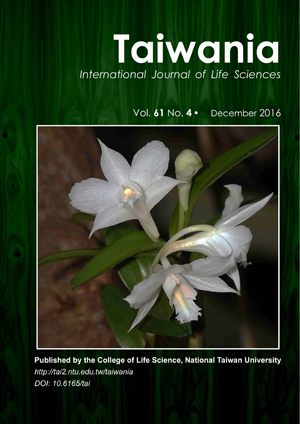Note
The rediscovery of Youngia atripappa (Babc.) N. Kilian in India after a century; its circumscription and nomenclature and the lectotypification of Crepis atripappa Babc.
Sentu Kumar Dey and Debabrata Maity
Published on: 14 November 2016
Page: 362 - 368
DOI: 10.6165/tai.2016.61.362
Abstract
Nomenclature and typification of Crepis gracilis Hook. f. & Thomson ex C.B. Clarke, C. atripappa Babc.,Youngia gracilis Hook. f. ex Babc. & Stebbins Youngia stebbinsiana S.Y. Hu and Y. atripappa (Babc.) N. Kilian are discussed. Y. atripappa (Babc.) N. Kilian is considered as correct name for the species following Kilian’s observation. The status of remaining names is also ascertained. Typification of Crepis atripappa Babc. is analyzed and the name is lectotypified following provisions of the present Code. Information on the rediscovery of the species after 105 years from India as well as of its type locality is provided. Population estimation was carried out in three successive years, from 2013 to 2015. Detailed description, illustrations, field photographs with related data are also provided for proper circumscription and to facilitate its correct as well as easy identification.
Keyword: Crepis atripappa, India, Lectotypification, Rediscovery, Sikkim Himalaya, Type locality, Youngia atripappa.
Literature Cited
Babcock, E.B. 1928. New Species of Crepis from Southern Asia. University of California Publications in Botany 14: 323
Babcock, E.B. and G.L. Stebbins. 1937. The Genus Youngia Cass. Carnegie Inststitute of Washington Publication 484: 1
Cassini, H. 1831. Descriptions de quelques Synanth?r??s de l
Clarke, C.B. 1876. CompositaeIndicae.Thacker, Spink & Co., London.
Hooker, J.D. 1881. Compositae. In. Hooker, J. D. (ed.), The Flora of British India. Vol.III. L. Reeve & Co. London. pp. 219
Kamelin, R.V. and S.S. Kovalevskaya.1993.Youngia Cass. In. Adylov, T. A. and Zuckerwanik, T. (eds), Conspectus Florae Asiae Mediae10:137
Ledebour, C.F. 1843
Maity, D. 2005. Vascular Plant Diversity of Kanchenjunga Biosphere Reserve, Sikkim. Ph. D. thesis, University of Kalyani (unpublished).
Maity, D. and G.G. Maiti. 2010. Taxonomic delimitation of the genus Tibetoseris Sennikov and the new genus Pseudoyoungia of the Compositae-Cichorieae from Eastern Himalaya. Compositae Newsletter 48: 22
Mamgain, S.K. and R.R. Rao. 1995. Asteraceae (Anthemideae-Heliantheae). In. Hajra, P.K., R.R. Rao, D.K. Singh and B.P. Uniyal (eds.), Flora of India.Vol. 12.Botanical Survey of India, Calcutta.
McNeill, J., F.R. Barrie, W.R. Buck, V. Demoulin, W. Greuter, D.L. Hawksworth, P.S. Herendeen, S. Knapp, K. Marhold, J. Prado, W.F. Prud
Myers, N., R.A. Mittermeier, C.G. Mittermeier, G.A.B. da Fonseca and J. Kent. 2000. Biodiversity hotspots for conservation priorities. Nature 403(6772): 853
Rao, R.R., H.J. Chowdhery, P.K. Hajra, S. Kumar, P.C. Pant, B.D. Naithani, B.P. Uniyal, R. Mathur and S.K. Mamgain. 1989. Florae Indicae Enumeration-Asteraceae. Botanical Survey of India, Calcutta.
Sennikov, A.N. and I.D. Illarionova. 2008. Generic delimitation of the subtribe Ixeridinae newly segregated from Crepidiinae (Asteraceae
Zhu, S. and N. Kilian. 2011. Youngia Cass. In. Wu, Z.Y., P.H. Raven and D.Y. Hong (eds.) Flora of China.Vol. 20-21 (Asteraceae). Science Press (Beijing) & Missouri Botanical Garden Press (St. Louis). pp. 252


